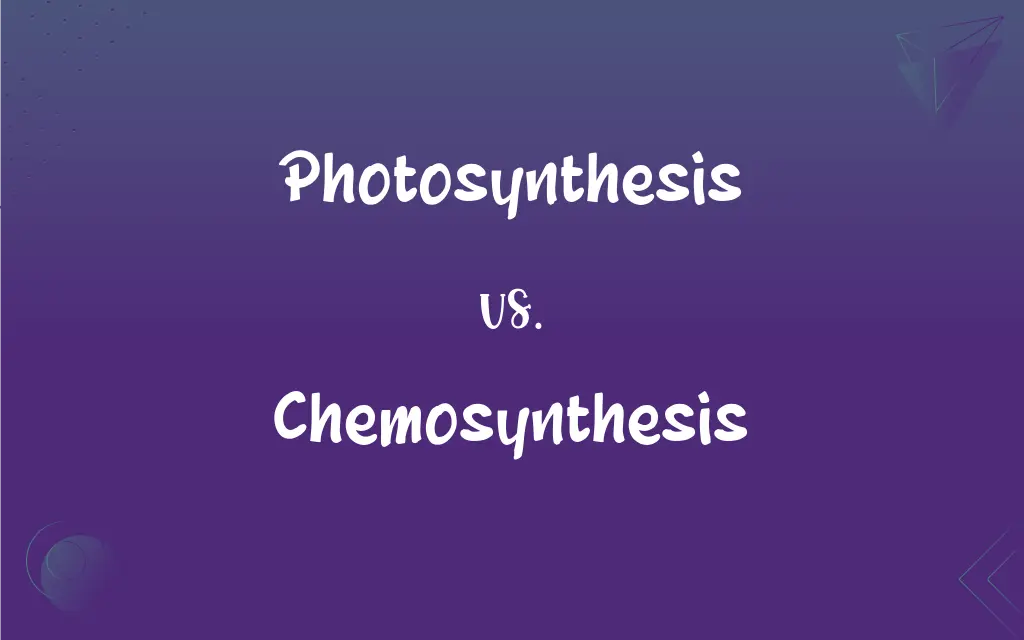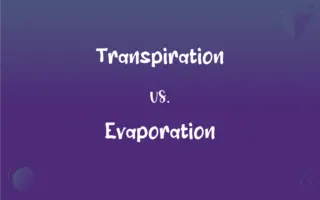Photosynthesis vs. Chemosynthesis: What's the Difference?
Edited by Aimie Carlson || By Harlon Moss || Updated on October 12, 2023
Photosynthesis utilizes sunlight to create energy in plants, while chemosynthesis generates energy in organisms using chemicals instead.

Key Differences
Photosynthesis generally involves the conversion of light energy into chemical energy by living organisms. On the contrary, chemosynthesis does not require light and involves organisms deriving energy from chemical reactions instead. Both processes are crucial in producing energy, but they occur in vastly different environments and organisms.
Photosynthesis typically occurs in environments exposed to sunlight, where organisms, primarily plants, and certain algae, convert sunlight, water, and carbon dioxide into glucose and oxygen. Chemosynthesis, however, predominantly takes place in dark, isolated environments like hydrothermal vents in ocean floors, where organisms convert inorganic compounds into energy.
Photosynthesis significantly impacts the environment by producing oxygen, which is essential for most life forms on Earth. While chemosynthesis also plays a vital role in supporting life, especially in extreme, isolated environments, the organisms involved utilize chemicals like methane or hydrogen sulfide to produce energy without releasing oxygen.
Photosynthesis includes light-dependent reactions that occur in the chloroplasts of plant cells. Contrastingly, chemosynthesis happens primarily in bacteria and other microorganisms, using enzymes to catalyze energy production from chemical compounds. Both mechanisms are energy-production means, adapted to their specific environments and necessities.
Photosynthesis is arguably more widely recognized due to its global impact and presence in all green plants. In contrast, chemosynthesis is often lesser-known but crucially supports life in some of the Earth’s most extreme environments, demonstrating life's adaptability and diversity in energy production strategies.
ADVERTISEMENT
Comparison Chart
Energy Source
Light energy from the sun
Chemical energy from inorganic compounds
Typical Organisms
Plants, some algae, and bacteria
Certain bacteria, especially in deep-sea environments
Environmental Impact
Produces oxygen
Does not produce oxygen
Location/Environment
Typically in sunlight-exposed areas
Often in dark, isolated environments
Substrates and Products
Uses water and carbon dioxide, produces glucose
Utilizes chemicals like hydrogen sulfide, produces energy without oxygen
ADVERTISEMENT
Photosynthesis and Chemosynthesis Definitions
Photosynthesis
Photosynthesis is a vital process for oxygen production in the Earth’s atmosphere.
The oxygen we breathe is produced through the process of photosynthesis in plants and algae.
Chemosynthesis
Chemosynthesis is vital for supporting ecosystems in isolated, extreme environments by providing a base for the food chain.
The chemosynthetic bacteria at hydrothermal vents support deep-sea ecosystems by serving as primary producers.
Photosynthesis
Photosynthesis is the biological process whereby light energy is converted into chemical energy in plants.
Photosynthesis in plants is crucial for converting sunlight into usable energy.
Chemosynthesis
Chemosynthesis is a biological process that utilizes chemical reactions to produce energy in the absence of sunlight.
Certain bacteria rely on chemosynthesis to generate energy in dark, deep-sea environments.
Photosynthesis
Photosynthesis involves transforming carbon dioxide and water into glucose, using sunlight.
Through photosynthesis, plants effectively create their own food using sunlight, water, and carbon dioxide.
Chemosynthesis
Chemosynthesis often occurs in environments lacking sunlight, like hydrothermal vents, where organisms derive energy from chemicals.
In the abyssal zone of oceans, organisms utilize chemosynthesis to survive where sunlight cannot penetrate.
Photosynthesis
Photosynthesis includes light-dependent and light-independent (Calvin cycle) reactions.
In photosynthesis, light-dependent reactions are fundamental for producing the energy required for creating glucose in the subsequent stages.
Chemosynthesis
Chemosynthesis enables organisms to produce energy without requiring organic matter as a substrate.
Utilizing inorganic compounds, chemosynthesis allows specific bacteria to thrive in nutrient-scarce environments.
Photosynthesis
Photosynthesis occurs in the chloroplasts of plant cells, utilizing chlorophyll to capture light energy.
Chloroplasts in plant cells are the key organelles where photosynthesis takes place, converting light into energy.
Chemosynthesis
Chemosynthesis involves the conversion of inorganic compounds into energy and organic matter, particularly in some bacteria.
Chemosynthesis uniquely enables certain microorganisms to survive and proliferate in environments devoid of sunlight.
Photosynthesis
The process in green plants and certain other organisms by which carbohydrates are synthesized from carbon dioxide and a source of hydrogen (usually water), using light as an energy source. Most forms of photosynthesis release oxygen as a byproduct.
Chemosynthesis
The synthesis of organic compounds by certain bacteria, especially in deep-sea hydrothermal vents, using energy obtained from the chemical oxidation of simple inorganic compounds. Chemosynthesis is thought to have been used by the first forms of life on Earth.
Photosynthesis
(biology) Any process by which plants and other photoautotrophs convert light energy into chemical energy,
Chemosynthesis
The production of carbohydrates and other compounds from simple compounds such as carbon dioxide, using the oxidation of chemical nutrients as a source of energy rather than sunlight; it is limited to certain bacteria and fungi
Chemosynthesis
Synthesis of organic compounds by energy derived from chemical changes or reactions. Chemosynthesis of carbohydrates occurs in the nitrite bacteria through the oxidation of ammonia to nitrous acid, and in the nitrate bacteria through the conversion of nitrous into nitric acid.
Chemosynthesis
Synthesis of carbohydrate from carbon dioxide and water; limited to certain bacteria and fungi
FAQs
Where does photosynthesis typically take place in plant cells?
Chloroplasts.
What is the primary energy source in photosynthesis?
Sunlight.
In which organisms does chemosynthesis predominantly occur?
Certain bacteria.
What are the main substrates used in photosynthesis?
Water and carbon dioxide.
Does chemosynthesis involve sunlight?
No, it involves chemical reactions instead.
What is the primary purpose of photosynthesis?
To produce glucose and oxygen.
Is oxygen produced during chemosynthesis?
No, it isn’t.
Is photosynthesis exclusive to plants?
No, it also occurs in some algae and bacteria.
How are photosynthesis and chemosynthesis similar?
Both processes produce energy and support ecosystems.
How are photosynthesis and chemosynthesis different?
They utilize different energy sources: sunlight and chemical reactions, respectively.
What chemical is crucial for capturing light in photosynthesis?
Chlorophyll.
What kind of environments is chemosynthesis often found in?
Extreme environments like hydrothermal vents.
Can chemosynthesis occur in environments exposed to sunlight?
Yes, but it's commonly associated with dark environments.
How does photosynthesis impact the atmosphere?
It releases oxygen and absorbs carbon dioxide.
What is the role of chemosynthesis in the ecosystem?
It supports ecosystems in extreme environments, providing a base for the food chain.
Can photosynthesis occur in the absence of sunlight?
No, sunlight is crucial for photosynthesis.
Are plants involved in chemosynthesis?
Typically, no.
Does chemosynthesis contribute to atmospheric oxygen levels?
No, it doesn’t.
Are humans directly involved in photosynthesis?
No.
Are water and carbon dioxide used in chemosynthesis?
Typically, no, it uses inorganic compounds like hydrogen sulfide.
About Author
Written by
Harlon MossHarlon is a seasoned quality moderator and accomplished content writer for Difference Wiki. An alumnus of the prestigious University of California, he earned his degree in Computer Science. Leveraging his academic background, Harlon brings a meticulous and informed perspective to his work, ensuring content accuracy and excellence.
Edited by
Aimie CarlsonAimie Carlson, holding a master's degree in English literature, is a fervent English language enthusiast. She lends her writing talents to Difference Wiki, a prominent website that specializes in comparisons, offering readers insightful analyses that both captivate and inform.































































